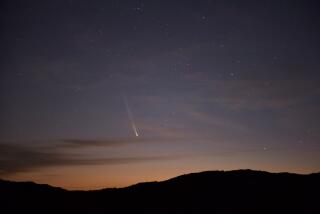SCIENCE / ASTRONOMY : Discovery of Distant Object May Offer Clues on Comets’ Origin
- Share via
Astronomers from the University of Hawaii and UC Berkeley have discovered the solar system’s most distant detected object, which appears to be a small, icy planetoid and could be one of millions forming a comet nursery near Pluto.
The body, temporarily named 1992 QB-1, is about 100 miles across, roughly 20% the size of Pluto. It is reddish, suggesting a surface rich in carbon compounds.
The shape of its orbit around the sun, a trip that takes about 200 years, will probably be determined by December, said David C. Jewitt, the University of Hawaii astronomer who observed QB-1 with UC Berkeley colleague Jane X. Luu.
If the orbit is highly elliptical, the object is a comet traveling in from even farther away, and it will eventually come close to the sun, providing a spectacular streaking fireball that “would light up the sky,” said Paul Weissman, a research astronomer at the Jet Propulsion Laboratory in Pasadena.
If the orbit is more circular, as Jewitt and Luu believe, it may be the first observational evidence of the Kuiper belt--a theorized region of planetary building blocks that never coalesced. Because they are so far from the sun, the objects, known as planetesimals, are icy rather than rocky like the asteroids in the inner solar system.
“The red color to us is an important clue (that it’s not a comet),” said Luu. “There are not very many objects that big that we know of that could be a comet.”
Most comets travel very long, slow routes that seem to come from a sphere-like area known as the Oort Cloud, located at the very outer edges of the solar system. An example is Comet Kahoutek, which takes millions of years to complete its eccentric orbit. Dutch astronomer Jan Oort predicted in 1950 that planetesimals surrounding the solar system could be dislodged from their orbits and grow comets’ tails as they hurtled toward the sun. If it exists, the Oort cloud is too faint and too far away to be detected with current technology.
But other comets, such as Halley’s Comet, which appears every 76 years, take much shorter paths and also seem to travel along the plane of the planetary orbits, rather than coming from all directions. Another Dutch astronomer, Gerard Kuiper, hypothesized in 1951 that a flat ring of planetesimals nearer the major planets could be the birthplace of these comets.
Weissman said: “This could be very much confirmation that we’ve found the first object in that region. It’s not certain yet but it’s looking very good.”
In the mid-1980s, several teams of astronomers embarked on the quest for the Kuiper belt.
It has been a difficult task. Telescopes that could detect very faint objects could not cover much of the sky. And instruments that could search wide swaths of sky could not reveal faint objects.
Then Jewitt and Luu began using an 88-inch telescope operated by the University of Hawaii on the slopes of the volcano Mauna Kea and coupled it with an electronic detector that is 100 times more sensitive than photographic film.
On Aug. 30 and 31 and on Sept. 1, they saw the object. They’ve talked of officially christening it “Smiley,” after the hero of John le Carre spy novels, once its orbit has been established.
The discovery was announced this week by the International Astronomical Union’s Central Telegraph Bureau, a Cambridge, Mass.-based clearinghouse for important observations.
Coupled with the discovery in January of Pholus, a similarly sized and colored object near Neptune, “this may be telling us something,” said Brian Marsden, the bureau’s director. “Pholus is just about where we expect the Kuiper belt to be beginning. I think Pholus managed to escape”--and in effect, is in the process of becoming a comet.
“This implies that there’s a whole new population of objects to explore. There must be more,” Luu said.
Anita L. Cochran, a University of Texas astronomer who also has been searching for the Kuiper belt, said the discovery, if confirmed as a planetesimal, would be a relief. “We have covered enough of the sky that it was beginning to get worrisome” that nothing had been found, she said.
“They actually found an object that’s much brighter than we’ve been looking (for),” Cochran said. “There should be a lot more within the limits of our detecting.”
But, she added, there is still a slight chance that the object could be “an oddball” rather than part of a huge ring of bodies.






